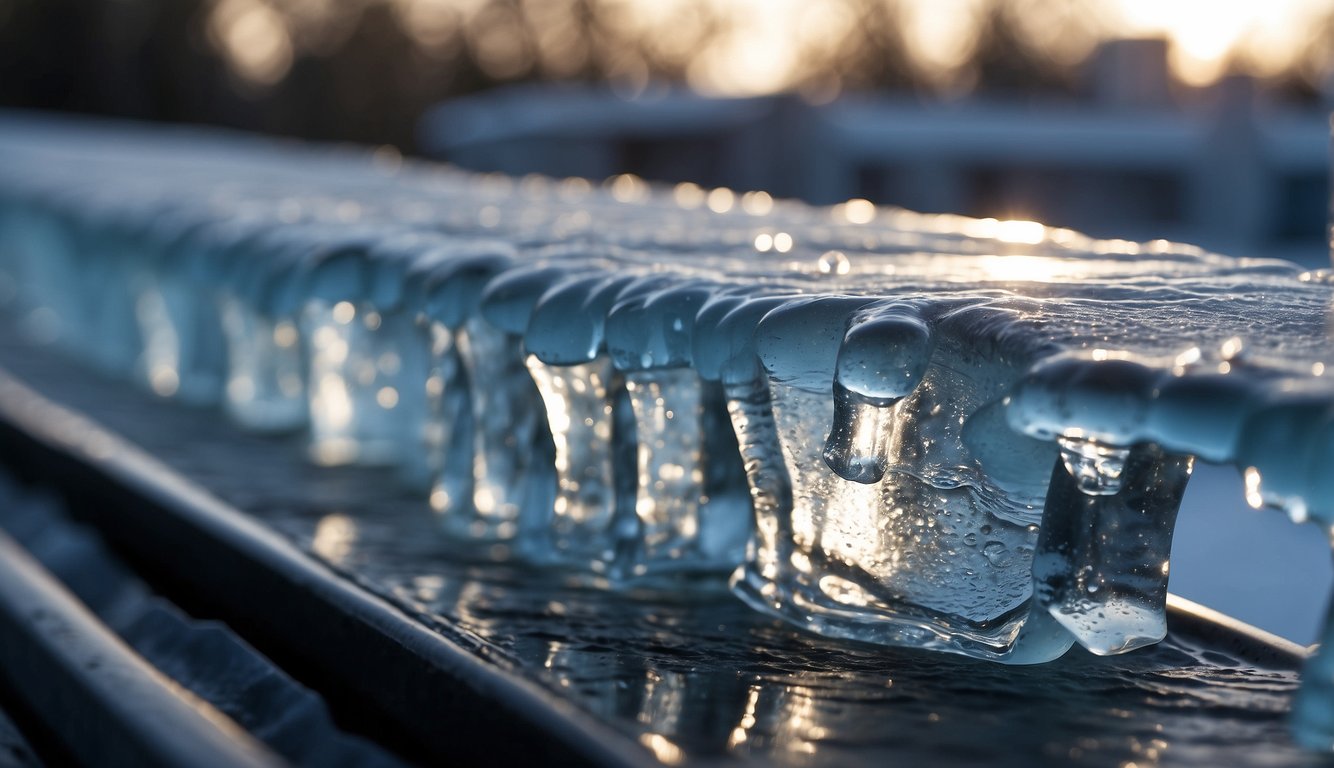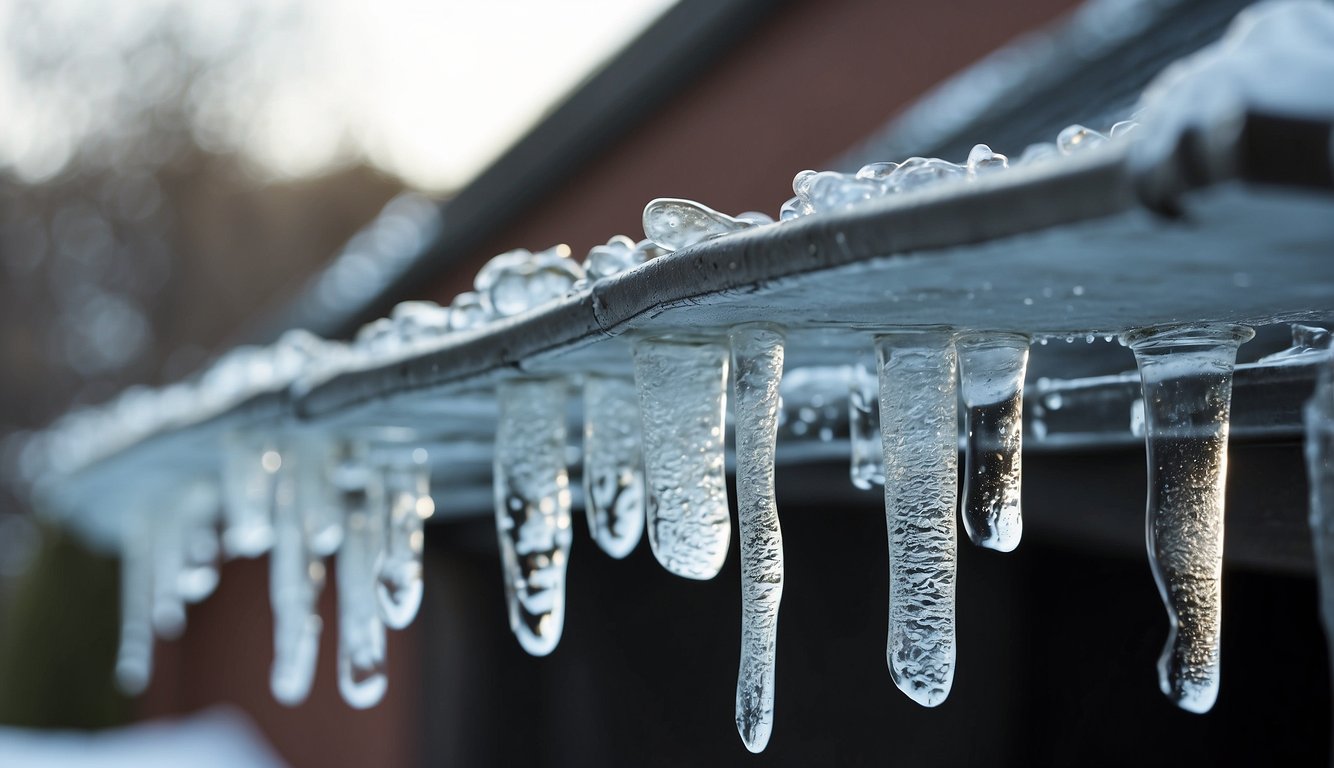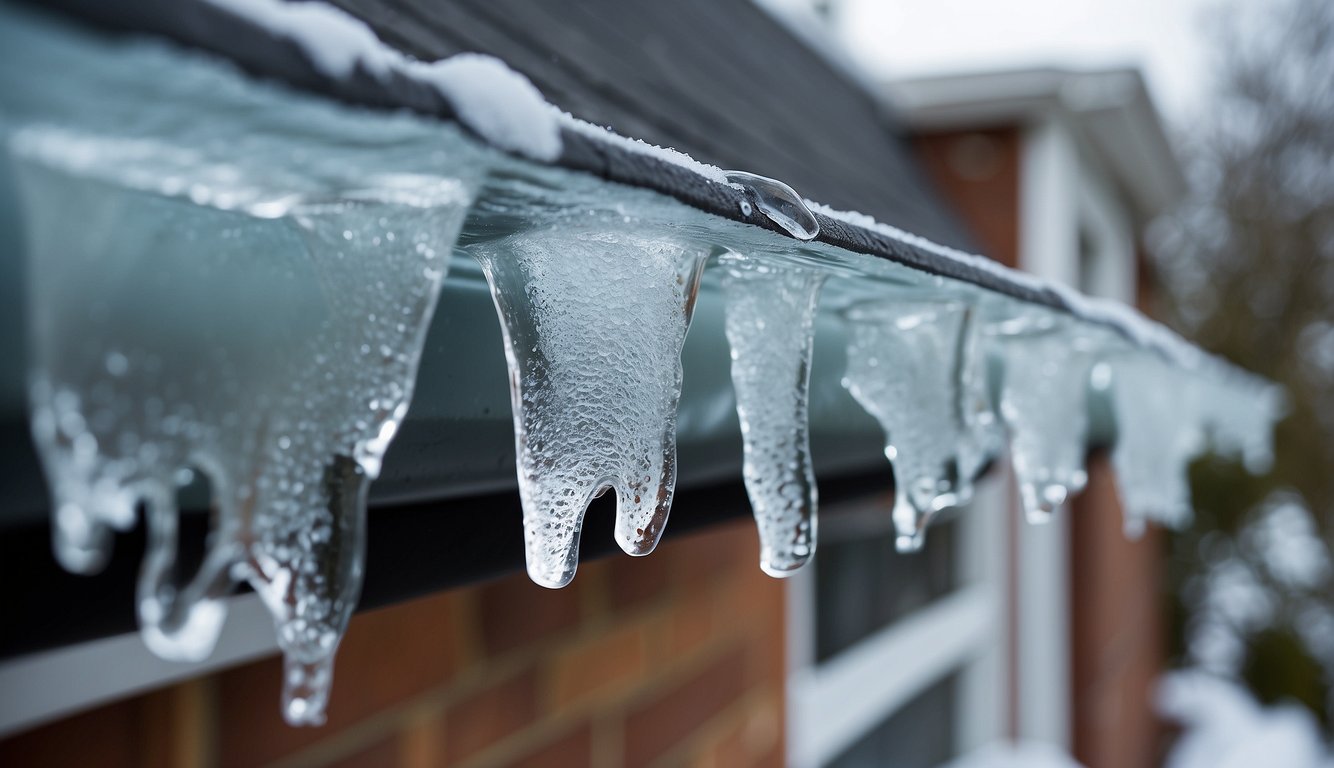How to Melt Ice in Gutters: Effective De-icing Techniques Explained
In the chill of winter, homeowners often face the challenge of ice formation in their gutter systems. We understand the importance of maintaining a clear pathway for melting snow to drain off your roof. When temperatures drop, this runoff can refreeze in gutters, creating hazardous ice buildups that may lead to damage. Melting ice in gutters is a crucial task to prevent the formation of ice dams and to protect the integrity of your home’s exterior.
Dealing with ice in your gutters doesn’t have to be a daunting task. Our experience suggests a few safe and effective methods to tackle this problem. You can use calcium chloride, a type of salt that effectively lowers the freezing point of water, to melt the ice without damaging your gutters. It’s a go-to solution that can be easily applied using items like pantyhose to create a slow-release system. Homeowners should avoid sodium chloride or rock salt, as these can harm your roof and vegetation.
Remember, safety comes first, so we always advocate for working from the ground if possible. Use tools like roof rakes to clear the snow off your roof, which in turn reduces the amount of water flowing into the gutters and refreezing. If the gutters have already frozen, placing calcium chloride in a stocking and laying it across the ice can gradually melt it away, allowing the water to flow freely again. Preventive measures are key, and we strongly recommend keeping your gutters clean to minimize ice buildup during the colder months.
Understanding Ice Formation in Gutters

When temperatures drop, snow buildup and cold weather can lead to the formation of ice dams in gutters. Let’s explore how these blockages occur and the impact they have on our homes.
Causes of Ice Dams
Ice dams occur when heavy snowfall accumulates on the roof and then melts during warmer parts of the day. This melted snow runs down the roof and refreezes in the gutters as temperatures fall again, especially at night. These ice dams block the gutters, preventing proper drainage and potentially leading to water seeping into the house, causing damage.
- Key Contributors:
- Variations in Temperature: Frequent shifts above and below freezing.
- Roof Heat Loss: Warm air escaping from the house heats the roof.
- Insulation & Ventilation Issues: Poor insulation and inadequate ventilation of the attic space.
Effects of Snow and Cold Weather on Gutters
Gutters are designed to channel water away from your home, but during cold weather, snow that collects on your roof can freeze in the gutters, becoming ice buildup. This ice in gutters can be problematic, as it adds weight and pressure, potentially leading to damage or even detachment.
- Risks to Gutters:
- Weight Strain: Ice adds considerable weight, leading to potential gutter detachment.
- Water Damage: Water from melting snow can leak into the home.
- Preventing Ice Dams:
- Keep the gutters clear of debris before the cold season begins.
- Ensure your attic is well insulated to minimize heat loss through the roof.
By understanding the dynamics of ice formation and addressing potential problems preemptively, we can prevent costly damages and ensure our gutters work effectively throughout the winter season.
Preventative Measures for Ice in Gutters

Ice formation in gutters can lead to damaging ice dams. We’ll discuss how proper insulation, installing gutter guards, heat cables, and regular cleaning can prevent this issue.
Insulating Your Attic Properly
Proper insulation in your attic is crucial for preventing heat loss through your roof, which can cause snow to melt and refreeze in gutters, forming ice dams. Ensure that the attic floor is well-insulated to maintain a consistent temperature that prevents the underside of the roof from warming excessively.
Installing Gutter Guards and Heat Cables
- Gutter Guards: These physically block debris, allowing water to flow smoothly and avoid ice buildup.
- Heat Cables: When installed along the edges of your roof, these cables provide enough warmth to prevent snow from freezing in gutters and downspouts.
Installing gutter guards and heat cables can be effective strategies. Gutter guards prevent leaves and debris from clogging the gutters, which can exacerbate ice formation. Heat cables, applied along the edges and within the gutter troughs, actively prevent ice by maintaining a temperature above freezing.
Regular Gutter Maintenance and Cleaning
- Frequency: Clean your gutters at least twice a year, in the spring and fall.
- Tools: Use tools like a roof rake after heavy snowfall to prevent snow from melting into your gutters.
Regular gutter maintenance and cleaning are perhaps the most straightforward measures to prevent ice dams. Keeping gutters free of leaves, twigs, and other debris ensures proper water flow and reduces the risk of ice buildup. Additionally, trimming overhanging tree branches can decrease the amount of debris falling into the gutters.
Safe Ice Melting Techniques

When we talk about removing ice from gutters, safety and effectiveness are our top priorities. Let’s focus on methods that use materials gentle on your gutters and environment, ensuring they’re clear without causing damage.
Applying Calcium Chloride
To melt ice in gutters, we can safely apply calcium chloride, an effective deicer that operates at much lower temperatures than salt and doesn’t harm your gutters or nearby plants. Unlike rock salt, calcium chloride does not have corrosive effects. Calcium chloride ice melter is a good choice for this job.
Materials Needed:
- Calcium chloride deicer
- Ladder (if safe to use)
- Gloves and eye protection
Procedure:
- Ensure you’re dressed in cold-weather gear with gloves and eye protection.
- Carefully position the ladder to access the gutter (if necessary and safe to do so).
- Scatter calcium chloride along the gutter, allowing it to pierce through the ice.
Using the Stocking Method
The stocking method is a classic, effective way to target ice melting in your gutters specifically. Here’s how you can use this technique:
Materials Needed:
- Old pantyhose or stockings
- Calcium chloride ice melter
Procedure:
- Fill the foot of an old stocking or pantyhose with calcium chloride.
- Securely tie off the open end.
- Place the filled stocking onto the gutter so that it lays across the ice.
With these methods, you should see a marked improvement in ice buildup, keeping your gutters functioning even in the coldest weather.
Mechanical Ice Removal Methods
When ice dams form in gutters, it’s crucial to remove them carefully to prevent damage to your roof and shingles. We can employ various mechanical methods to address these icy obstructions safely and effectively.
Using Roof Rakes and Sharp Tools
Roof Rakes: We recommend using a roof rake with an extendable handle to reach the gutters comfortably from the ground. This prevents the need for ladders and reduces the risk of injury.
- Steps to Use a Roof Rake:
- Extend the rake’s handle to reach the gutters.
- Position the rake head horizontally at the edge of the gutter, then pull down towards the ground.
- Carefully rake the snow and ice out of the gutters, ensuring not to damage the shingles.
Sharp Tools: For tougher ice dams, ice picks or other sharp tools can be beneficial. However, increased caution is necessary to avoid harm to the gutters or yourself.
- Guidelines for Ice Picks:
- Gently chip away at the ice dam in small sections.
- Never stab or violently hit the ice as it can damage the gutters.
- Aim for the larger chunks of ice that are easier to remove without affecting the roof.
Professional Gutter Cleaning Services
Leave it to the Pros: Sometimes, ice removal can be too dangerous or complex. In these cases, seeking professional gutter cleaning services might be the best course of action.
- Advantages of Professional Services:
- They possess the right tools and experience for extreme ice removal tactics.
- They understand how to increase ventilation to avoid future ice dam formation.
- Professionals will handle the task without risking damage to your roof or gutters.
Handling Emergencies and Damage

When ice accumulates in gutters and downspouts, it can lead to water damage and the need for urgent repairs. We’ll discuss how to address water damage and when it’s time to call in the professionals.
Addressing Water Damage and Leaks
If you notice that ice has caused your gutters to leak into your home, it’s crucial to act promptly. Water damage can lead to mold growth and structural issues if left unaddressed. Here’s a brief list of immediate actions:
- Locate the source: Find where the water is entering and assess the severity.
- Minimize damage: Use buckets or towels to collect water and move valuables away from the affected area.
- Dry the area: Use fans or dehumidifiers to dry out wet areas to prevent mold growth.
When to Contact Professionals for Gutter Repair
Not all damage can be handled alone, especially if the situation involves risk to your property or safety. Be mindful of the following scenarios:
- Significant Damage: If trees have fallen on your gutters or there’s notable damage to your siding, professional repair is necessary.
- High and Inaccessible Damage: If certain areas are not safely reachable with your equipment, call for professional help.
- Complex Repairs: When damage extends beyond the gutters and affects the roof or home’s structure, professional expertise is required.
Utilize de-icing methods such as applying calcium chloride in stockings hung over the gutters to melt ice. Avoid direct application of de-icers as they can damage your gutters and downspouts. Warm water can be used in emergencies, but this is only a temporary fix and can lead to refreezing if temperatures drop again. Regular maintenance and prompt repair will keep your gutter system functioning properly and protect your home from water-related damage.
Let Us Know How We’re Doing!
Did this expertly prepared resource answer your question?
Do you have another question about home maintenance, home improvement projects, home appliance repair, or something else?
Get more information, send in questions and keep the discussion going by contacting the I’ll Just Fix It Myself company customer service team at at 1-800-928-1490 or Email us at [email protected]
